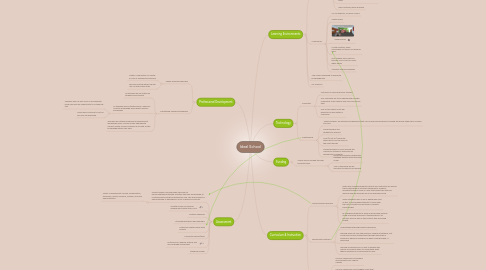
1. Professional Development
1.1. Highly Qualified Teachers
1.1.1. Master of Education or Master or Arts in Teaching is preferred
1.1.2. will have scored within the top 15% on their Praxis tests
1.2. Maintaining Teaching Standards
1.2.1. All teachers will be tested on student improvement
1.2.2. All teachers will be tested every 2 years on content knowledge and subject specific knowledge
1.2.2.1. Teachers who do not score in an adequate range will have an opportunity to re-take the test
1.2.2.2. Those who continue to not do will may be dismissed
1.2.3. Teachers will attend professional development workshops every 2 years in their appropriate subject matter to aid in staying up to date on the knowledge within their field
2. Assessment
2.1. Project Based Learning lends itself well to performed/demonstrated activities that can be assessed at multiple points along the production line. The final product is demonstrated or defended in front of peers and faculty.
2.1.1. Points of assessment include: collaboration, teamwork, drafts, revisions, critique, and final demonstration.
2.2. Growth model for tracking achievement rather than SOLs
2.3. Multiple measures
2.4. Standardized tests used sparingly
2.5. Interactive white boards with clickers
2.6. Computer games/tasks
2.7. Portfolios for reading, writing, and oral language assessment
2.8. Standard Grades
3. Curriculum & Instruction
3.1. Project-Based Learning
3.1.1. Basic idea: engage students interest and motivation by having them participate in activities designed to answer a question/problem solve in a way that reflect the types of learning and work people do in the everyday world
3.1.2. When students learn in an in-depth way such as this, it encourages students to encounter the real concepts and principles of what’s being taught
3.1.3. by teaching students to work in groups and learn by using real world problems it teaches them 21st century skills as well as the content they are being taught
3.2. Experiential Learning
3.2.1. understanding through direct experience
3.2.2. learning does not only take place by reading a textbook, but could also be done interactively through field trips or bringing in physical examples of what is being taught, if applicable
3.2.3. learning by experience is a way to engage the learner by allowing them to understand what they’re learning on a more personal level
3.3. Honors Classes
3.3.1. Honors classes will be available and separate from regular classes
3.3.2. Honors classes will count slightly more than regular class towards an overall students’ GPA
3.3.3. Students will need to show high potential for success, recommendation letters, etc. in order to be allowed to participate in honors courses
4. Learning Environments
4.1. Building & Grounds
4.1.1. Square building design with inner courtyard accessible by classrooms. Courtyard has student-tended garden and room for class activities.
4.1.2. Natural lighting, warm & colorful walls (murals, geometric shapes, etc.) & carpeted areas
4.1.3. LEED certified, green building
4.2. Classrooms
4.2.1. 20-25 students, inclusion rooms
4.2.2. Center areas
4.2.3. Reading area
4.2.4. Cluster seating, easily rearranged for group or individual work
4.2.5. Anti-fatigue back mats for teacher use in front of every white board
4.2.6. Students actively engaged
4.3. Year-round schooling to eliminate knowledge gap
4.4. No uniforms
5. Technology
5.1. Computer
5.1.1. Not given to each and every student
5.1.2. One computer lab to be shared with enough computers to be used by any one class at any time
5.1.3. One or two laptop carts per grade to be used within a classroom
5.2. SmartBoards
5.2.1. -What are they? An interactive whiteboard that can be used by physically touching the board rather than clicking a mouse
5.2.2. Allow teachers and students to interact
5.2.3. Most (if not all) computer applications can be used on the smart boards
5.2.4. Allows teachers to move around the classroom instead of being strictly behind their computer
6. Funding
6.1. School will be funded through property taxes
6.1.1. Funds will be evenly distributed between schools from one state coffer
6.1.2. 10% of the funds will be allocated to districts as needed
